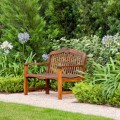Houston Landscaping Plants
Houston’s semi-tropical, humid climate offers many opportunities for landscaping design. Residents of our city complain at times about the heat and humidity, but plant life actually loves it. There are so many different types of grasses, flowers, shrubs, vines, and trees we can plant here that we truly have unlimited design possibilities right in our own back yards. To get the best results, we recommend you let us help you first by developing a landscape master plan, and then selecting the best Houston landscaping plants that will compose the organic elements of that plan.
Let’s look today at the many different types of Houston landscaping plants we can use to create all types of landscape designs.
Garden plants are probably the first thing that comes into most people’s minds when you say the word “landscaping.” By definition, landscaping is a deliberate sculpting of the raw forms of nature. A landscape without a garden is very rare, because a garden is in actuality a form of softscape (that means plant life) sculpture.
There are many types of Houston landscaping plants that are used to build gardens. Depending on the style of garden design, there may be everything from ornamental grasses to full-sized trees in a garden. We have to think beyond the image of a flower bed when we talk about gardens, because many of the plants we use create patterns of green and dimensions of form that are every bit as important as color.
Grasses are probably the most overlooked category of Houston landscaping plants. When we hear “grass,” we visualize San Augustine grass and walk over it with our thoughts as quickly as we do with our feet. In reality, however, grasses are a very important part of Houston landscaping design. Not only are they essential to certain types of gardens, but they also form significant softscape borders around homes, walkways, and patios.
We try to use indigenous species to the extent appropriate to a particular landscape design. Grasses that are native to Southeast Texas include brown top millet, coastal sandbur, hairy wooly grass, bamboo grass, mesquite grass, and several others too numerous to list. A combination of only three or four of these grasses is enough to transform a problematic area in your yard into an attractive point of interest and beauty.
Another important type of Houston landscaping plants are ground cover species. Simply put, ground cover plants do exactly what their name says. They cover the ground. Ground cover fulfills two important functions. In one role, it acts as a lawn alternative in places where grass does not grow. In another role, it adds limited vertical impact and color to an area we want to emphasize.
There are many native and nonnative ground cover plants we can use in your yard, depending on what works best for your home architecture and outdoor lifestyle. From a practical perspective, it is always wise to use native plants for at least part of your garden and accent softscapes. Native species have adapted to our problematic weather. The fact that we still have living plants in our yards in spite of this recent drought testifies to this fact of hardy adaptation. More exotic species may or may not make it through such times, depending on where they originate.
Plants like jasmine, rosemary, verbena, and honeysuckle often ensure that no matter what the weather does, the yard looks attractive, neat, warm, and inviting.
Native shrubs and trees are also very important Houston landscaping plants. Our part of the world is very flat, and vegetation that creates vertical impact is vital to a complete design. A yard that has various levels of aesthetic appears more robust and alive. Its fullness invites you to step into it. This makes you feel like you are actually living in another type of home, not just sitting in space outside your home.
A few examples of these shrubs and trees include both small and large species of boxwoods, many types of rose bushes, honey locust, mountain laurel, and juniper. Many trees from other parts of the world do very well here in Houston. Japanese yew, for example, makes excellent tree walls in yards that border other yards without fences. Other trees like oak that may already be growing in your yard provide shade cover that can be used to shelter areas of special interest like shade gardens or morning garden fountain patios.
With so many viable choices, the most certain way to get the very best Houston landscaping plants is to let us recommend different species for different specific softscapes. To do this effectively, we must first create a big picture, almost like a frame, and fill it in with hardscapes to create internal boundaries and structures.
Then and only then will we know the very best Houston landscaping plants to use in your gardens, and which ones to plant around your outdoor buildings, patios, courtyards, and walkways.
This will prevent you from choosing what you think might look good in a certain place in your yard, only to realize better you could have planted something else there that would better have supported your forms. With Exterior Worlds as your guide, you are sure to fulfill your own expectations the first time around.


